 Indians Archive
Indians Archive  View from the Porch: 2012 Cleveland Indians Season Preview
View from the Porch: 2012 Cleveland Indians Season Preview
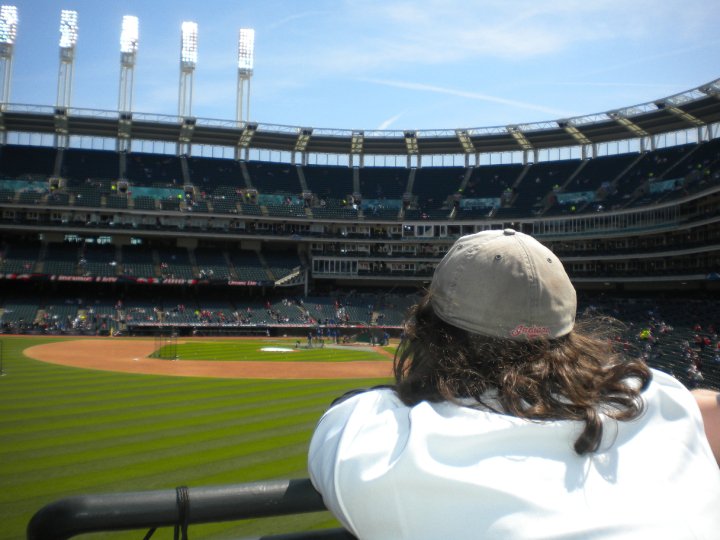 BASEBALL IS BACK!! Despite what 2007 showed us about winter, the return of baseball should mean the end of the annoying white stuff flying around Northeast Ohio and summer nights at the ballpark are just a couple of months away. The Home Opener is this Thursday, April 5, and it truly is a joyous occasion. The start of a new season always brings optimism, even if you’re a fan of the team with the second-longest World Series Championship drought in baseball. Even Cubs fans get optimistic this time of year.
BASEBALL IS BACK!! Despite what 2007 showed us about winter, the return of baseball should mean the end of the annoying white stuff flying around Northeast Ohio and summer nights at the ballpark are just a couple of months away. The Home Opener is this Thursday, April 5, and it truly is a joyous occasion. The start of a new season always brings optimism, even if you’re a fan of the team with the second-longest World Series Championship drought in baseball. Even Cubs fans get optimistic this time of year.
Thursday will mark my ninth straight Home Opener, a number that began during my sophomore year of high school and one that I plan to continue until I’m not breathing for the Home Opener. It really is Cleveland’s holiday. Obviously, 2007 is the most memorable of Home Openers due to the horrendous weather and the start of a truly magical season. I remember freezing through rain/snow mixes, standing through chilly sunny days, overcast days with looming snow clouds but no precipitation, little, bitty stinging rain, and big fat rain. Pretty much everything except severe thunderstorms.
And I wouldn’t trade any of it for anything.
It’s a day that I wait for from the time the last pitch of the season is thrown. I don’t sulk about the past season, 2007 excepted. I instead start focusing on the future, looking to see how the team can get better and move forward. I like to think that’s how our front office works as well. I think we’re a better team this season than we were last season. I think things are moving in the right direction. Outside of the perks associated with becoming a season ticket holder, the reason I wanted to lock in a ticket package was the playoff priority that came along with it. The way things are shaping up this season, using playoff priority as a factor in my decision making shows my optimism for the season. Over 162 games, anything can and will happen. It’s just a matter of more good things than bad happening to the Cleveland Indians.
Since the season begins before my next installment of the View from the Porch, there’s no time like the present to give you my VftP 2012 Cleveland Indians Season Preview. It will be full of statistics that will exemplify why I think the Indians will be a surprise team this season. At the end, I’ll focus just on the month of April and I hope to preview the next month of the season with my final column of every month.
Happy baseball season everybody!
On January 23, I was really happy with the Indians’ offseason and the way that things were progressing. The Indians had brought in Derek Lowe on a bargain deal where the Braves covered two-thirds of his $15M salary and only wanted a Single-A reliever in return. Hopes were high that the Indians would get one of Derrek Lee or Casey Kotchman to fix the hole at first base. The Indians added depth through minor league free agent signings of guys with Major League experience. We’d have a full year of Jason Kipnis. Michael Brantley and Shin-Soo Choo had no lasting effects from the injuries that cut their 2012 seasons short. The team had just added Kevin Slowey into the mix after the Roberto Hernandez Heredia fiasco and had solid starting pitching depth. Unfortunately, our old friend Victor Martinez had torn his ACL and would miss the season. Sad for him, but it definitely boosted the Indians’ chances in the AL Central Division.
The next day, the Tigers signed Prince Fielder. For the low price of nearly three times the Indians payroll, Cecil Part Deux became my public enemy number one. In an instant, the happiness I felt about the Indians roster melted away. My first thought wasn’t about how awful the Tigers defense would be or how Alex Avila and Doug Fister were due for some serious regression, it was “Damnit, that team’s going to outslug everybody.”
In the two-plus months since that day, I have wavered back and forth about what to expect from this year’s Tribe. As is par for the course here in Cleveland, every scenario of us contending begins with an “if” statement. “If we stay healthy”, “If Ubaldo returns to form”, “If Verlander ruptures his Achilles in a trampoline accident” (sorry Joba the Hut Chamberlain, too soon?), “If Chisenhall can hit”, and so on and so on.
For as long as I can remember, the Indians have failed when expectations have been high. Even in the 90s, the team’s glory years, they never won it all. In 2006, the season after the Indians had collapsed in the final week, costing them a wild card berth, the team fell flat on their faces like a drunk chick on a college campus who doesn’t see the curb in front of her. In 2008, when the front office inexplicably failed to plug the holes that 2007’s overachievement had masked, the team was out of the race by June, ending that month 10 games out of first. There have been no preseason expectations since.
Expectations for the Indians this year are mixed, both with Indians fans and media members alike. Some people are enamored with the Indians 30-15 start to 2011 and view that as a more accurate gauge of the team than the 50-67 record after the first 45 games. Some look at the injuries that the Indians had to deal with last season and think that a healthy bunch can be a contender. Others view the Tigers as an insurmountable foe, towering over Cleveland as the embodiment of 48 consecutive years of sports despair.
For me, I see both sides. I have my doubts that the Tigers can, in fact, be dethroned from their preseason position as winning the AL Central with ease. Vegas oddsmakers, based on opening over/under betting lines, projected the Tigers to win the Central by 15 games. I also have my hopes and dreams. My hopes that Alex Avila will drastically drop off from his unsustainable .366 BABip (batting average on balls in play or Hits / (At Bats – Strikeouts)), that Doug Fister will not continue to have a 10/1 strikeout-to-walk ratio like he did after the Tigers acquired him in July, and that the Tigers infield is, quite possibly, the worst defensive infield ever constructed. My hope that Miguel Cabrera will run head first into a brick wall and have a career path like that of Justin Morneau’s, mired by concussions and the unreasonable expectations of “Past MVP” hanging over his head. My hope that Jhonny Peralta will remember that he is actually a .270 hitter with average power and a horrible defender.
The Indians winning the AL Central Division would not be like Buster Douglas knocking out Mike Tyson or like the 1980 US Men’s Olympic Hockey Team beating the Russians. It would certainly be an upset, but not of epic proportions. It can happen. There are ways that we can enjoy playoff baseball. It starts with the 2012 Cleveland Indians roster.
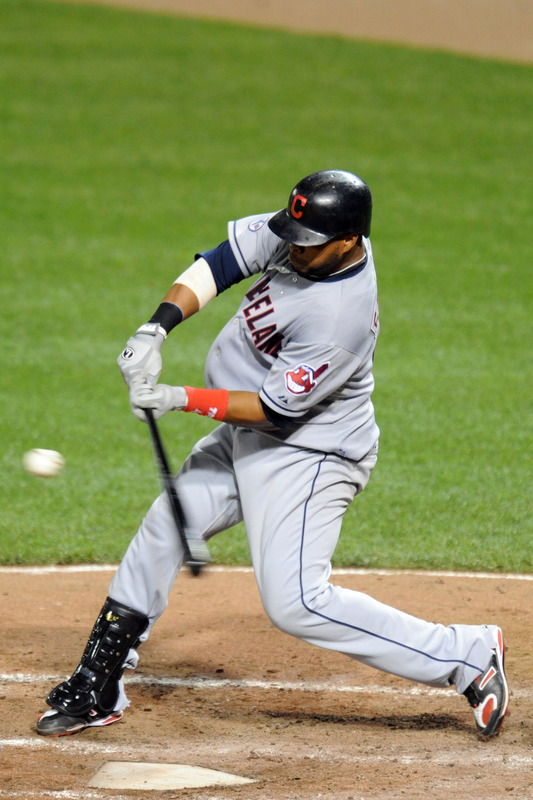 Projected Lineup:
Projected Lineup:
(vs. RHP; 2011 stats v. RHP, AVG/OBP/SLG/OPS)
CF Michael Brantley (.289/.335/.447/.782)
SS Asdrubal Cabrera (.265/.331/.468/.799)
RF Shin-Soo Choo (.254/.347/.410/.757)
C Carlos Santana (.202/.315/.420/.736)
DH Travis Hafner (.302/.404/.482/.886)
2B Jason Kipnis (.276/.327/.551/.878)
LF Shelley Duncan (.273/.331/.587/.918)
1B Casey Kotchman (.313/.394/.444/.838)
3B Jack Hannahan (.226/.314/.358/.673)
Bench: 2B/SS/3B/OF Jason Donald, C Lou Marson, IF Jose Lopez*, OF Aaron Cunningham/Ryan Spilborghs*
* - to be determined
This lineup clearly lacks the big names of other AL Central Division lineups. There is no Miguel Cabrera. No Prince Fielder. No Alex Gordon. No Eric Hosmer. No Joe Mauer. No Paul Konerko. What there is, however, is a lot of balance. Theoretically, the Indians could have five 20 HR guys from those players (Cabrera, Choo, Santana, Hafner/Duncan, Kipnis). The ones who don’t hit 20 should hit 15 or slightly more.
Clearly, the key against RHP will be Carlos Santana. His OBP is excellent for how pathetic his batting average was. His slugging percentage was lower than it should have been because slugging percentage is (Total Bases / At Bats), so because Santana didn’t have many hits, he didn’t pick up as many total bases. There are two reasons for this. One, he struck out in 24% of his AB against RHP. The other is that 20.3% of his at bats against RHP resulted in IFFB, or, infield fly balls. This tells us that his swing plane was off against RHP, mostly from becoming “homer-happy”. With strikeouts and infield pop ups, Santana effectively wasted 44.3% of his right handed at bats. On the flip side, against LHP, Santana only struck out 11.6% of the time and popped up on the infield just 9.8% of the time. The good news about this is that it’s fixable. It’s psychological and mechanical. Putting good level swings on the baseball can be fixed in the batting cage with the manager and hitting coach. This is cause to be optimistic about Santana’s upcoming season. The Indians can identify the problem and fix it.
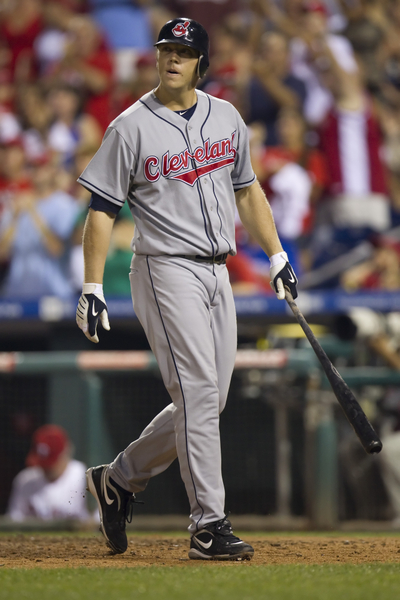 Projected Lineup
Projected Lineup
(vs. LHP; 2011 stats v. LHP)
CF Michael Brantley (.214/.282/.243/.525)
SS Asdrubal Cabrera (.291/.333/.444/.777)
RF Shin-Soo Choo (.269/.336/.352/.688)
DH Carlos Santana (.318/.428/.536/.964)
LF Shelley Duncan (.245/.316/.363/.679)
2B Jason Kipnis (.263/.349/.395/.744)
1B Casey Kotchman (.289/.340/.369/.709)
3B Jack Hannahan (.296/.367/.444/.811)
C Lou Marson (.297/.387/.407/.794)
Bench: 2B/SS/3B/OF Jason Donald, DH Travis Hafner, IF Jose Lopez*, OF Aaron Cunningham/Ryan Spilborghs*
This lineup will probably not look the same very often. With a handful of bench players who do far better against left handed pitching (Marson, Jason Donald, Aaron Cunningham/Ryan Spilborghs), the Indians will be able to keep guys like Travis Hafner fresh. Against tough lefties, Jason Kipnis, Michael Brantley, or Shin-Soo Choo can get a day off. The Indians bench options are significantly better than the 2011 version, especially in games against LHP. Luckily, for the Indians, only seven of the 20 starters they can regularly expect to see in the AL Central are left handed (Chen, Duffy, Sanchez, Danks, Sale, Liriano, and Duensing). Note that none of them are Detroit Tigers. Travis Hafner had just a .638 OPS against LHP in 2011. The Indians can limit his workload and maximize his productivity by giving him days off against LHP.
The biggest red flag against LHP is Michael Brantley. Unfortunately for the Indians, they don’t really have another center fielder on the roster. Choo, who has his shortcomings against LHP as well, is the closest thing we have to a backup CF. That’s why the Indians were trying to work with Jason Donald in Spring Training. For his career, over 148 plate appearances against LHP, Donald is batting .328/.405/.481/.886. If he can become a CF option against lefties, that would be huge for the Tribe’s overall depth, help to keep guys healthy, and limit certain players’ exposure to LHP. The Indians’ ground ball rotation could allow Donald to play CF with few balls hit his way.
You can see why there’s reason for optimism with the Indians lineup(s). The team can use players in certain spots to maximize their strengths and minimize other players’ weaknesses. It could be a frustrating year for fans who like when a manager sticks with one everyday lineup, but Manny Acta has plenty of tools in his toolbox when it comes to constructing this year’s lineup.
Projected Rotation (W-L, ERA, FIP*, IP, WHIP**):
* - FIP stands for Fielding Independent Pitching, a metric that measures a pitcher’s ERA assuming that BABip (batting average on balls in play) is league average, essentially, if a pitcher has an average defense behind him and adds emphasis on things that pitchers can control (walks, strikeouts, home runs, and hit batters). FIP is widely-regarded as one of the best ways to predict future ERA because it eliminates “bad luck” or bad defense which can change from season to season.
** - WHIP stands for walks + hits per inning pitched, or the number of baserunners a pitcher allowed per innings, minus hit batters and errors
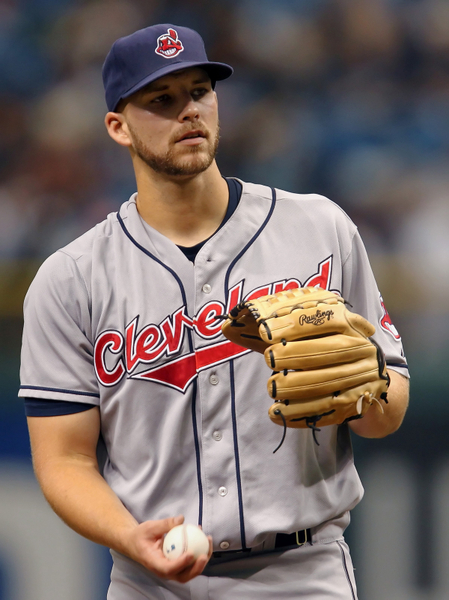 RHP Justin Masterson (12-10, 3.21 ERA, 3.28 FIP, 216 IP, 1.28 WHIP)
RHP Justin Masterson (12-10, 3.21 ERA, 3.28 FIP, 216 IP, 1.28 WHIP)
RHP Ubaldo Jimenez (10-13, 4.68 ERA, 3.67 FIP, 188.1 IP, 1.4 WHIP); with Indians (4-4, 5.10 ERA, 3.85 FIP, 65.1 IP, 1.45 WHIP)
RHP Derek Lowe (9-17, 5.05 ERA, 3.70 FIP, 187 IP, 1.51 WHIP)
RHP Josh Tomlin (12-7, 4.25 ERA, 4.27 FIP, 165.1 IP, 1.08 WHIP)
RHP Jeanmar Gomez (5-3, 4.47 ERA, 4.12 FIP, 58.1 IP, 1.51 WHIP)
The reason for the elongated definition of FIP is to get your hopes up about the Indians’ pitching staff this season. The two key guys in the staff, Ubaldo Jimenez and Derek Lowe, are expected to be better this season. The Indians, one of the most advanced front offices in baseball regarding statistical player analysis, must also believe this. Derek Lowe is projected to be drastically better. When people talk about “regression” with pitchers, they are generally referring to outliers, statistics that are way off the norm or far from other statistics, much like Derek Lowe’s ERA and FIP. For FIP, a 4.00 is considered “average”. 3.75 is considered “above average”. FIP takes away the “fluky” seasons. BABip, referenced a couple times in this column, does the same for hitters.
If the FIPs for Jimenez (career 3.60 FIP) and Lowe (career 3.79 FIP) come to fruition, and they are strikingly close to last year’s FIPs, the Indians project to have one near-great starter in Masterson, two above average starters, and two guys ever-so-slightly below average. However, as fourth and fifth starters, for Tomlin and Gomez to be slightly below average, that’s an upgrade over what most teams have.
Even with Gomez’s injury in Friday’s start, the Indians, due to the April off days (mentioned later), will be just fine to wait on him until he’s back healthy.
Projected Bullpen (W-L, SV/Holds*, ERA, IP, WHIP):
* - Holds are essentially saves (use same definition as 9th inning save) that occur before the 9th inning
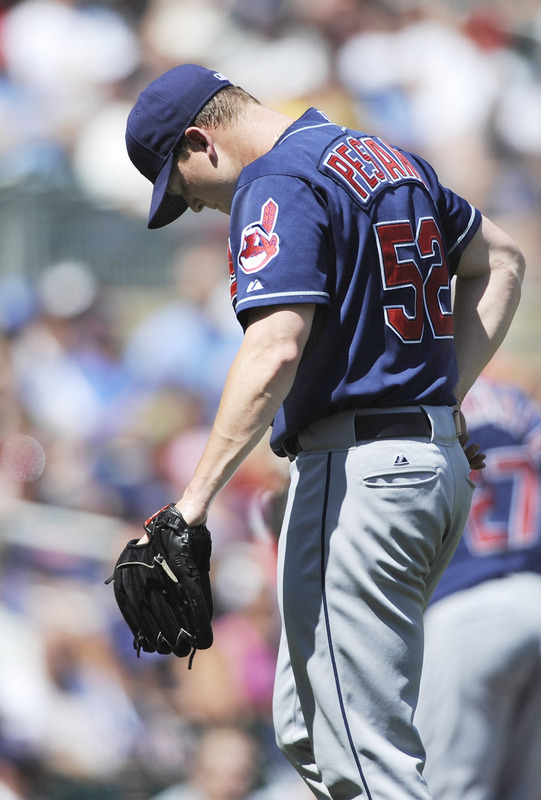 Closer: Chris Perez (4-7, 36 SV, 3.32 ERA, 59.2 IP, 1.21 WHIP)
Closer: Chris Perez (4-7, 36 SV, 3.32 ERA, 59.2 IP, 1.21 WHIP)
RHP Vinnie Pestano (1-2, 23 HLD, 2.32 ERA, 62 IP, 1.05 WHIP)
RHP Joe Smith (3-3, 16 HLD 2.01 ERA, 67 IP, 1.09 WHIP)
LHP Rafael Perez (5-2, 12 HLD, 3.00 ERA, 63 IP, 1.24 WHIP)
LHP Tony Sipp (6-3, 24 HLD, 3.03 ERA, 62.1 IP, 1.11 WHIP)
RHP Dan Wheeler (2-2, 4 HLD, 4.38 ERA, 49.1 IP, 1.11 WHIP)
RHP Jairo Asencio (0-0, 0 HLD, 6.97 ERA, 10.1 IP, 2.03 WHIP)*
RHP Jeremy Accardo (3-3, 2 HLD, 5.73 ERA, 37.2 IP, 1.62 WHIP)*
* - to be determined
One of the team’s biggest strengths in 2011 was the bullpen. Quite frankly, it’s about the only reason they finished within one game of .500. The bullpen stayed shockingly healthy and the main five guys all thrived in their roles. Bullpens are highly volatile, so it’s reasonable to expect some regression from these guys this season.
Arguably, the biggest regression candidate is Chris Perez. Perez fought with his command and saw a drastic drop in his strikeout numbers. He went from 8.71 strikeouts per nine innings in 2010 to 5.88 in 2011. His ERA jumped over a run and a half. We don’t know what pitcher Chris Perez is - the one from 2010 or the one from 2011 or somewhere in between. He has the makeup of a closer and the mentality of a guy who wants the ball with the game on the line. That said, the drop in his strikeout totals and WHIP are definite cause for concern. His velocity also wasn’t all there in 2011, averaging 93.4 mph on his fastball, a drop from 2010’s 94.6 mph.
The middle relief and setup areas project to be solid again, with second-year eighth inning guy Vinnie Pestano, two solid matchup lefties in Tony Sipp and Rafael Perez, and a terrific righty setup guy in Joe Smith.
One thing to mention with the pitching staff is that pitching coach Tim Belcher stepped away from the game and was replaced by bullpen coach Scott Radinsky. What, if any, this effect will have on the pitchers, we don’t know until games start, but it’s certainly something to pay attention to.
The final 25-man roster decisions will likely be announced shortly after this column is posted, so keep an eye on TheClevelandFan.com or any of the Indians’ contacts on Twitter.
Overall, it’s a solid looking group, one that has to stay healthy and get a couple of guys to overachieve for a shot at toppling the Tigers. There is a lot of versatility on the roster to allow Manny Acta to put guys in positions to really succeed and there are a couple of key starting pitchers who should be significantly better than last season. We know that the camaraderie in the locker room will be there.
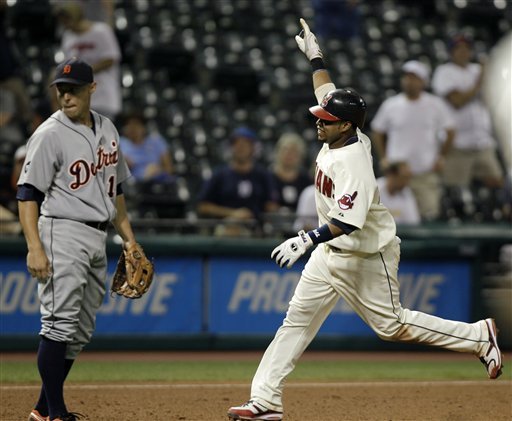 Getting off to a good start is crucial. The Indians April 2012 schedule can allow them to do that. The Indians have four off days in the first 18 days of the season due to their travel schedule and the obligatory off day after the Home Opener in case it gets postponed to the next day. The Indians start with six games at home, against the Blue Jays and the White Sox. The White Sox appear to be a team trending downward with a lot of personnel moves this offseason that would seem to be the start of a rebuild. After another off day on the 12th, the Indians head to Kansas City for three, before getting another off day to travel out west for a six-game swing through Seattle and Oakland. After yet another off day, the Indians host the Royals and Angels in two three-game homestands prior to the fifth off day of the month on April 30.
Getting off to a good start is crucial. The Indians April 2012 schedule can allow them to do that. The Indians have four off days in the first 18 days of the season due to their travel schedule and the obligatory off day after the Home Opener in case it gets postponed to the next day. The Indians start with six games at home, against the Blue Jays and the White Sox. The White Sox appear to be a team trending downward with a lot of personnel moves this offseason that would seem to be the start of a rebuild. After another off day on the 12th, the Indians head to Kansas City for three, before getting another off day to travel out west for a six-game swing through Seattle and Oakland. After yet another off day, the Indians host the Royals and Angels in two three-game homestands prior to the fifth off day of the month on April 30.
In the meantime, the Tigers play Boston, Texas, Tampa, and the Yankees all in the first month of the season. This should present a problem for the Tigers because hitting doesn’t come easy in April with the cooler temperatures and those four foes all have very good pitching. The Indians face some less than stellar pitching early on and I’m a big fan of early season long road trips because the players can get into their road routines and bond with their teammates. April sets up very well for the Tribe and will be a big month for them.
I hope you were able to stick it out through a pretty lengthy column profiling the Indians roster and what to expect. We may be playing the role of David, and Miggy Cabrera and Cecil Jr. Fielder may both literally look like Goliath, but there’d be nothing better than slaying those two beasts sometime in September.
- NBA Announces 2013-2014 Schedule
- Browns Ink Sharknado
- Sharknado A No-Show For Rookie Camp
- Trent Richardson Out Until Training Camp
- Browns Sign Brandon Jackson
- Carrasco Suspended Eight Games
- Browns Add to Wide Receiver Depth with David Nelson
- Browns Need to Learn from Past Draft Mistakes
- Browns Release Chris Gocong and Usama Young
- Browns Missing on Grimes Disappointing, But Not The End
The TCF Forums
- Chris Grant's first 3 drafts
Kingpin74 (Tuesday, January 21 2014 10:13 AM) - The 2014 Offseason Thread
googleeph2 (Tuesday, January 21 2014 9:36 AM) - 2015 Recruiting
furls (Tuesday, January 21 2014 6:57 AM) - Mike Brown
YahooFanChicago (Monday, January 20 2014 11:15 PM) - Movies coming out
HoodooMan (Monday, January 20 2014 9:34 PM) - 2014 Hoops Hockey Hijinx
jpd1224 (Monday, January 20 2014 4:44 PM) - 2014 Recruiting
jclvd_23 (Monday, January 20 2014 2:26 PM) - Wish List - #4 Pick
Hikohadon (Monday, January 20 2014 1:26 PM) - Official- Browns Coach Search/Rumors
OldDawg (Sunday, January 19 2014 6:48 PM) - #1 overall pick Anthony Bennett
TouchEmAllTime (Sunday, January 19 2014 1:28 PM)



